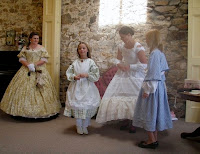Judul : 7 Tips for Writing Historical Fiction
link : 7 Tips for Writing Historical Fiction
7 Tips for Writing Historical Fiction
"The past is a foreign country: they do things differently there"
 |
| mural in Virginia City Nevada |
 |
| 1862 Directory |
Before I travel to a new country I always read a guide book about the history and customs. I do the same thing with travelling into the past. At the moment I’m reading books about the history of the American Civil War and the Silver Boom in Nevada. One of my best guide books is the 1862 Directory to Nevada Territory, an exact facsimile of the Wild West version of the yellow pages... or should I say 'Google'?
 |
| Bret Harte 1836-1902 |
Just as it’s good to learn a few phrases when travelling to a foreign country, I like to get the speech patterns of the past down. For my Roman Mysteries, I made the language modern but used lots of Latin words. For the P.K. Pinkerton Mysteries I’m storing up choice phrases from the letters of Mark Twain and the diaries of Alfred Doten. (e.g. Americans in the 1800s didn't use many contractions, but they loved the word ain't.) I also listen to audiobooks to get the speech rhythms right, just as I'd listen to some language podcasts before going to Italy or France. One of my current favourites is Great Classic Westerns read by marvellous narrators like Bronson Pinchot. I also love the stories of Bret Harte.
 |
| Dressing the west |
Take the right clothes for climate and culture. Wearing period clothing can really get you into the mindset of your characters and make them seem real and immediate. For my Roman Mysteries, I wore a linen stola and woollen palla, plus leather sandals based on a Roman template. For my new Western Mysteries series, I have bought a buckskin jacket and cowboy boots. At the Santa Clarita Cowboy Festival, I learned my buckskin was actually pigskin! And one of my best experiences was a demonstration of what western women wore under their skirts during the 1860s. This took place during a Civil War reenactment weekend in Virginia City at the Tahoe House Hotel. (left)
4. Food and Drink
The 19th century diarist Alf Doten tells me what he ate and drank on the Comstock in the 1860s. When I go to a foreign country, I want to eat what the locals do. Otherwise I may just as well stay home. Same thing when writing about the past. However, I do draw the line at grizzly-bear-cub mince-pies and oysters from tin cans, both dishes which Alf Doten appreciated. And I won't try the Pousse L'Amour drink in Professor Jerry Thomas's book on cocktails published in 1862: How to Mix Drinks, Or: The Bon-Vivant's Companion. If I did, I'd never get anything written!
 |
| Anne Dinsdale, weaver |
It’s always a good idea to talk to a native of the foreign country if you can. The historical author has a wonderful resource in re-enactment events. Men who dress up as Roman legionaries usually know exactly what each piece of armour is for. Women who wear corsets and hoop skirts can describe how itchy and dusty they get. A Nevada Cowboy Fast draw expert told me why you usually only have five bullets in a six-shooter; it’s safest to leave the first chamber empty. Living history experts are the closest you’ll get to interviewing a person from the past. There are a lot of amateurs and experts eager to share their knowledge with you.
 |
| Virginia City rabbit |
Even if your story takes place centuries or millennia ago, it’s always useful to visit the site of the event if possible. You’ll meet people who are experts on the history of their region and who might know things not in books or on the internet. Also, you’ll get an idea of climate: wind, air, light, pressure, humidity, etc. I always like to make a note of what food is in season, what flora is blooming and fauna are migrating. Research is a great excuse to travel. Writing an historical novel gives you lots of fun goals as well as icebreakers for starting conversations with the natives.
 7. Souvenirs
7. SouvenirsWhenever I visit the setting of one of my historical novels, I try to bring back a period artefact. It can be a genuine antique or a convincing replica. There is nothing like handling an object from your time period to bring it alive. If you write for children you can bring some of these artefacts to festivals, libraries and schools and let the kids handle them. My three favourites are my replica sponge-on-a-stick (ancient Roman toilet paper), my as of Domitian (an antique coin) and my brass spittoon from the 1890’s. (left)
 |
| paperback cover |
The first book in my P.K. Pinkerton Mysteries series is The Case of the Deadly Desperados. It is available in hardback, paperback, Kindle and MP3 audio download.
Book #2, The Case of the Good-looking Corpse and book #3, The Case of the Pistol-Packing Widows, are out, too!
And you can find out about all my books on my website www.carolinelawrence.com
Demikianlah Artikel 7 Tips for Writing Historical Fiction
Sekianlah artikel 7 Tips for Writing Historical Fiction kali ini, mudah-mudahan bisa memberi manfaat untuk anda semua. baiklah, sampai jumpa di postingan artikel lainnya.
Anda sekarang membaca artikel 7 Tips for Writing Historical Fiction dengan alamat link Sapiens





